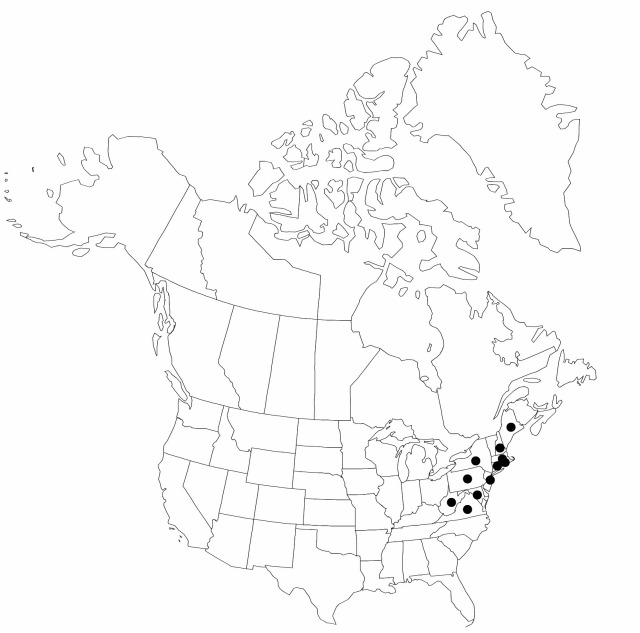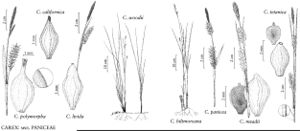Difference between revisions of "Carex polymorpha"
Descr. Gram., 239. 1817.
FNA>Volume Importer |
imported>Volume Importer |
||
| (6 intermediate revisions by 2 users not shown) | |||
| Line 6: | Line 6: | ||
|place=239. 1817 | |place=239. 1817 | ||
|year=1817 | |year=1817 | ||
| + | }} | ||
| + | |special_status={{Treatment/ID/Special_status | ||
| + | |code=F | ||
| + | |label=Illustrated | ||
| + | }}{{Treatment/ID/Special_status | ||
| + | |code=E | ||
| + | |label=Endemic | ||
| + | }}{{Treatment/ID/Special_status | ||
| + | |code=C | ||
| + | |label=Conservation concern | ||
}} | }} | ||
|basionyms= | |basionyms= | ||
| Line 24: | Line 34: | ||
|distribution=Conn.;Del.;Maine;Md.;Mass.;N.H.;N.J.;N.Y.;Pa.;R.I.;Va.;W.Va. | |distribution=Conn.;Del.;Maine;Md.;Mass.;N.H.;N.J.;N.Y.;Pa.;R.I.;Va.;W.Va. | ||
|discussion=<p>Of conservation concern.</p><!-- | |discussion=<p>Of conservation concern.</p><!-- | ||
| − | --><p>Carex polymorpha, rare throughout its range, is of conservation concern (L. A. Standley and J. L. Dudley 1991).</p> | + | --><p><i>Carex polymorpha</i>, rare throughout its range, is of conservation concern (L. A. Standley and J. L. Dudley 1991).</p> |
|tables= | |tables= | ||
|references= | |references= | ||
| Line 33: | Line 43: | ||
-->{{#Taxon: | -->{{#Taxon: | ||
name=Carex polymorpha | name=Carex polymorpha | ||
| − | |||
|authority=Muhlenberg | |authority=Muhlenberg | ||
|rank=species | |rank=species | ||
| Line 47: | Line 56: | ||
|publication title=Descr. Gram., | |publication title=Descr. Gram., | ||
|publication year=1817 | |publication year=1817 | ||
| − | |special status= | + | |special status=Illustrated;Endemic;Conservation concern |
| − | |source xml=https:// | + | |source xml=https://bitbucket.org/aafc-mbb/fna-data-curation/src/2e0870ddd59836b60bcf96646a41e87ea5a5943a/coarse_grained_fna_xml/V23/V23_784.xml |
|genus=Carex | |genus=Carex | ||
|section=Carex sect. Paniceae | |section=Carex sect. Paniceae | ||
Latest revision as of 20:43, 5 November 2020
Plants colonial, long-rhizomatous. Culms 30–60 cm, scabrous to smooth distally. Leaves: proximal sheaths fibrillose, bladeless, brown- to reddish purple tinged, 2–4.5 mm diam.; ligules 2–10 mm, longer than wide; largest blades green, flat, 4–45 cm × 2.5–6 mm. Inflorescences 6–19 cm, 1.4–2.2 times longer than proximal bract; proximal bracts 2–9 cm; sheath 0.6–2 cm, blade 1.5–7 cm; proximal spikes pistillate or androgynous; lateral spikes cylindric, 1.5–3.5 cm × 7.5–11 mm; terminal 1–3 spikes, staminate. Pistillate scales purple or brown, apex rounded or obtuse. Perigynia densely arranged, green to light brown, 2-ribbed and finely veined, 4.2–6.8 × 1.5–2.5 mm, with low, broad papillae; beak purple tinged, mouth hyaline, obliquely bidentate, asymmetrically flared, 0.8–1.8(–2.2) mm. Achenes light to dark brown, 2.2–2.8 × 1.4–2.3 mm.
Phenology: Fruiting early–mid summer.
Habitat: Thin woods with sandy soils
Elevation: 30–1200 m
Distribution

Conn., Del., Maine, Md., Mass., N.H., N.J., N.Y., Pa., R.I., Va., W.Va.
Discussion
Of conservation concern.
Carex polymorpha, rare throughout its range, is of conservation concern (L. A. Standley and J. L. Dudley 1991).
Selected References
None.
